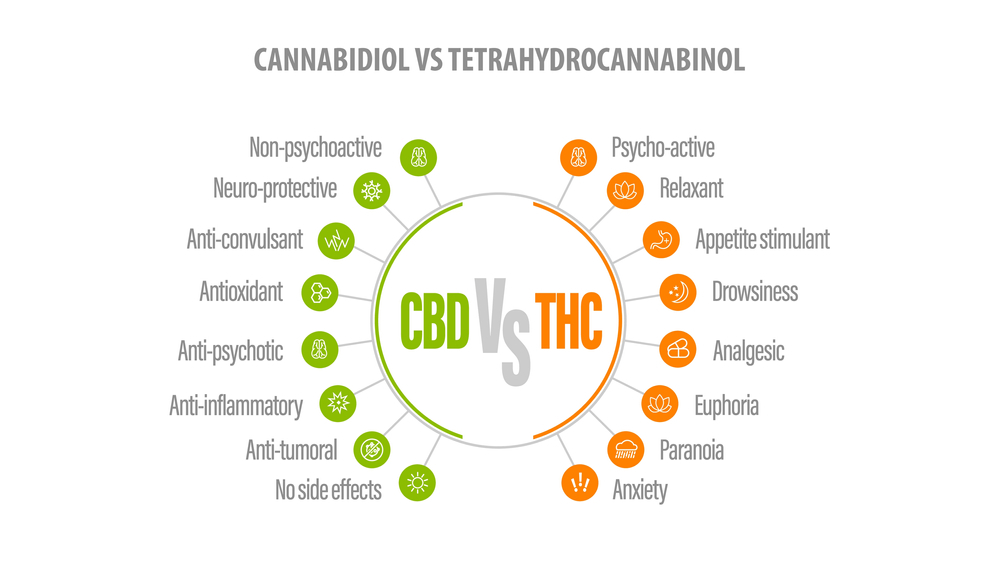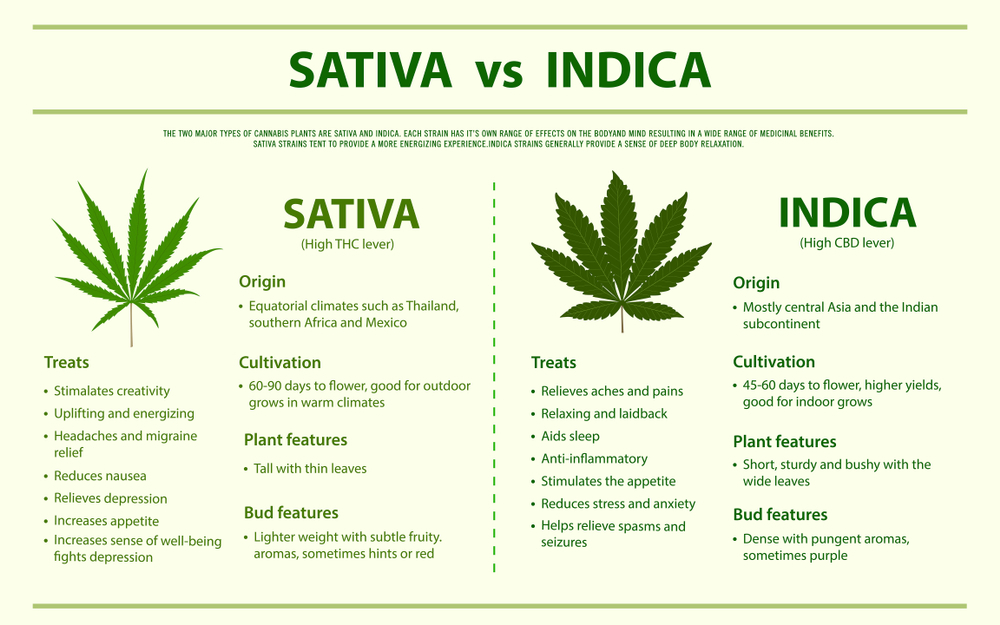Cannabis buds have distinctive smells and tastes that avid smokers can recognize in seconds. These characteristics often help them differentiate between the bad, the good, and the oh-so-great strains! But how do weed plants get their signature smell? There’s chemistry at work here!
Like most other plants, the cannabis plant contains hundreds of naturally occurring compounds that can be broadly classified into a handful of categories. The two most important types of compounds found in cannabis are cannabinoids and terpenes. Compounds from both of these categories give cannabis plants the smell, taste, and signature psychoactive properties they’re known for.
What are Cannabinoids?
Cannabinoids are naturally occurring chemical compounds found in the cannabis plant. What separates them from other cannabis compounds is that they actively interact with the human body to produce various effects. In many ways, cannabinoids can be considered the ‘active’ compounds present in cannabis.
While most people know only two cannabinoids (the famed THC and CBD), cannabis contains more than 100 cannabinoids. Further, CBD makes up 40% of the resin extract derived from cannabis plants.
The effects that cannabinoids have on the human body depend on the type of cannabinoid and the quantity in which they are consumed. While some cannabinoids like CBD are known for their medicinal properties, others like THC are famous for their effects on brain-related functions like cognition and perception of time. But how exactly do they affect the human brain? The answer has to do with some light biochemistry.
How Do Cannabinoids Work?
To understand how cannabinoids interact with the human body, it is important to understand the concept of cannabinoid receptors first. The human body is a fascinatingly complex organism controlled by chemicals called enzymes. Whenever a person’s body needs something (food, water, sleep, and so on), it starts producing enzymes as a signal. These enzymes trigger receptors in different parts of the brain and the central nervous system, making the person feel hungry, thirsty, or sleepy.
Human beings have a central and local endocannabinoid system that controls important functions like cognition, motor skills, emotional regulation, metabolism, and pain control. These endocannabinoid receptors are triggered by certain chemicals, including cannabinoids.
Supplying the body with cannabinoids (in the form of weed) triggers certain effects in people, including feelings of euphoria, insomnia, increased appetite, and altered cognitive abilities, among other things. All this is caused by the endocannabinoid receptors in and around the brain. However, that still leaves us with local endocannabinoid systems. So what exactly do they do?
Local endocannabinoid systems are usually located in the body’s dermal (skin) and muscular regions. Applying cannabinoid-rich products like weed balms and salves in these places triggers the local endocannabinoid systems, leading to effects like muscle relaxation, pain relief, and quicker healing of skin-related ailments like rashes and infections.
Types of Cannabinoids
While there are more than 100 cannabinoids present in cannabis, only a handful of them are popularly known due to their effects. So let’s take a look at some of them.
Cannabigerol (CBG)
CBG is a non-intoxicating compound, bringing no ‘high’ to the user. Instead, it has been associated with effects such as pleasure augmentation and inspiration boosting, regulating appetite and sleep habits while providing pain relief. With its mildness towards humans, products that contain CBG are legally allowed in the United States of America.
Cannabichromene (CBC)
CBC can be considered a lesser-known and less potent cousin of CBD. CBC is usually present in much lower quantities in cannabis plants and has no immediately notable effects like CBD. The primary function of CBC is to interact with the nervous system to control inflammatory diseases and the neuropathic pain caused by them. Like most others, CBC is a non-psychoactive, mildly potent cannabinoid, which is why it is completely legal at the federal and state levels.
Cannabidiol (CBD)
CBD is one of the most abundant cannabinoids found in the cannabis plant. While it is non-psychotropic, it is used for various medicinal purposes. For example, CBD effectively treats different conditions surrounding nerve, pain, and anxiety-related disorders ranging from skin inflammation to Parkinson’s disease. A specific form of CBD is even approved in the US to treat rare epileptic and sclerotic seizures.
Tetrahydrocannabinol (THC)
As mentioned above, THC is responsible for the psychoactive effects of cannabis. It essentially interacts with specific endocannabinoid receptors in the brain to produce a wide variety of effects, from increased appetite to sleepiness and slower motor movements.
But has anyone explored the medicinal advantages of this drug beyond its common psychoactive effect? Absolutely! Not only is THC one of the strongest cannabinoids, but it also produces several effects on our bodies almost immediately. Scientists have successfully used these properties to treat several medical issues, such as chemotherapy-induced nausea and appetite loss in AIDS patients.
Cannabinol (CBN)
Cannabinol is another psychoactive compound present in cannabis plants. While it has much milder effects compared to THC, it is used for certain medicinal purposes. For example, CBN is used as an appetite stimulant and to ease feelings of nausea. Some studies also point to its efficacy in the treatment of glaucoma.
Cannabinodiol (CBDL)
CBDL is an aromatic compound formed when a cannabis plant absorbs sunlight and undergoes a photochemical reaction with CBD. Like CBD, CBDL is non-psychoactive and is typically used for its mild medicinal benefits.
So, if it isn’t clear by now, there are many therapeutic and medical properties within these tiny but mighty compounds!
Cannabinoid Benefits
The therapeutic benefits of cannabinoids are countless due to their interaction with the endocannabinoid system in our bodies. Cannabinoids interact with different receptors in the nervous system, muscles, and brain to relieve pain, reduce inflammation, improve moods, and even help regulate sleep cycles. Cannabinoids also have neuroprotective properties that can help protect the brain from damage, supporting healthy cognitive and motor development.
Let’s take a deeper dive:
Enhancing appetite
Have you ever had intense cravings for snacks after consuming cannabis? Those infamous munchies result from cannabinoids interacting with endocannabinoid receptors in your body. This fantastic property causes an alteration in metabolism and can even increase appetite! Cannabinoids have been used to induce hunger when treating patients who suffer from illnesses such as AIDS that stifle metabolic processes.
Pain relief
Pain is generated when the brain interprets chemical signals. Thankfully, cannabinoids can be used to suppress pain. These compounds interact with our Central Nervous System (CNS) and limit a person’s capacity to feel discomfort.
Stress and anxiety relief
Stress and anxiety are psychological processes linked to a person’s nervous system. Cannabinoids affect the body by synthesizing enzymes to combat stress and help people manage mental strain more effectively, similar to how they reduce pain.
Soothing skin-related problems
This is where the local endocannabinoid systems come into the picture. Novel research conducted in the last decade has proved the existence of endocannabinoid systems in skin tissue. These systems help maintain the overall homeostasis (balance) and healing mechanisms of the skin. Using cannabinoid-rich products like balms, salves, and lotions on inflamed or irritable skin can help it gain moisture and heal faster.
Cannabinoid Side Effects
Despite their attractive medicinal benefits, cannabinoids can also have some side effects.
Dizziness
Endocannabinoid systems play a significant role in controlling the body’s motor systems. Therefore, consuming cannabinoid-rich substances in large quantities can severely affect these systems’ ability to regulate movement, causing the person to lose balance and move slower than usual.
Difficulty in cognitive abilities
Ever tried studying or working while under the influence of cannabis? Sometimes it can get difficult to focus and think clearly due to the cannabinoids altering your neurological systems. Logical and cognitive problem-solving abilities dampen considerably due to the effect of cannabinoids on the human body. Cannabinoids affect nerve cells in such a way that they can cause difficulties in memory recall, making it harder to stay focused on tasks.
Irritability
While irritability is generally linked with erratic and possibly violent behavior, it simply means being unable to control one’s moods effectively. Endocannabinoid receptors play a central role in mood regulation. While consuming cannabinoids in the right quantities can put you in a pleasant mood, an overdose can cause a person to experience mood swings and display signs of anxiety and paranoia in some cases.
Dry mouth
Most cannabis consumers are familiar with the notorious ‘dry mouth’ it can cause. But what’s behind it? The salivary glands around a person’s throat have endocannabinoid receptors, which control saliva production. Consuming cannabinoids affect the balance of these receptors and cause the saliva to become thicker, leading to a dry, cottony feeling in the mouth. The worst part is that drinking water won’t help much if you’ve consumed a sizable amount of weed.
What are Terpenes?
Terpenes are aromatic oils found in cannabis and many other plants. They give the plant its characteristic scent and flavor qualities, such as lemon, pine, or skunk. While they do not have any notable psychoactive effects, terpenes have been linked to mild medicinal benefits such as stress and anxiety relief and mood regulation. Additionally, they are believed to make the effects of cannabinoids more potent.
How Do Terpenes Work?
Terpenes are believed to affect the endocannabinoid system in our bodies, enhancing its ability to react to cannabinoids. Cannabinoids interact with our receptors to produce their effects, but terpenes can supplement this process by binding themselves with the receptor sites and increasing the efficacy of certain cannabinoids. Research suggests that certain combinations of Cannabinoids and terpenes create a synergistic effect, making them considerably more potent than they would be on their own.
Some terpenes interact with the brain to stimulate the release of dopamine – the ‘reward’ hormone, and serotonin – the feel-good hormone. This helps reduce stress and improve our overall mood. Other terpenes can open up blood vessels, allowing more oxygen to enter the brain and improving cognitive performance.
Contemporary medicine is now beginning to highlight the importance of cannabinoids and terpenes in human health. Both are believed to work together to deliver therapeutic benefits that help regulate our neurological and physiological systems. With time, we can expect more of what cannabis offers regarding medicinal benefits. However, there’s no denying that the wonder plant has much to provide us with!
Types of Terpenes
There are various types of terpenes found in cannabis, each with its array of therapeutic benefits.
Limonene
Limonene, as the name suggests, is responsible for the citrusy, lemony smell of citrus fruits. However, it is most notably used for its anti-inflammatory, anti-diabetic and antioxidant properties.
Pinene
Pinene is the terpene responsible for the fresh, sometimes minty smell found in pine trees and rosemary plants. It is primarily used in aromatherapy and other nature-based treatments. Some studies suggest that Pinene has antimicrobial, anti-inflammatory, and antioxidant properties.
Linalool
Linalool is the terpene that gives lavender plants their signature pleasant smell. It is most commonly used in aromatherapy and other scent-based therapeutic practices. Ever wondered why so many relaxing bath bombs, oils, and lotions are lavender-scented? It’s because of linalool!
Myrcene
Myrcene is responsible for the fresh, herby smell found commonly in plants like lemongrass, hops, and thyme. It is considered to be a powerful antioxidant. A 2014 study found that myrcene can be used to protect the brain from oxidative damage following a stroke. Mycrene’s antioxidant properties are also avidly advertised in the marketing of lemongrass-based herbal teas.
Terpene Benefits
While terpenes are nowhere near as potent as cannabinoids, medical research has found them to have palpable psychological and physiological effects on human beings. Here are a few notable benefits of terpenes:
Anti-microbial
Some plants produce terpenes to defend against bacteria, parasites, and other microorganism-based infections that can severely damage them. This gives terpenes potent anti-microbial properties that can be used to treat infected and inflamed skin.
Analgesic
Terpenes are also believed to have the potential for use as an analgesic or pain-relief medication. However, they are most importantly viewed as alternatives for highly addictive analgesic drugs available on the market.
Stress relief
As mentioned earlier, terpenes directly interact with the production of dopamine and serotonin in the human body. This makes them effective as mood regulation and stress relief medication. In addition, different aromatic weed products like bath bombs, essential oils, and candles are often used by people to destress and unwind after a long day.
Antihyperglycemic
Some studies have found plant-based terpenes to be excellent antihyperglycemic or glucose-controlling agents. They are specially used for regulating glucose levels in patients with type 2 diabetes.
Terpene Side Effects
Unlike cannabinoids, terpenes do not have any significant side effects. This can, in part, be attributed to the fact that they do not interact much with any major neural or endocrine (gland-based) systems in the human body.
However, terpenes can act as local irritants at times. When used in the wrong proportions, terpenes can lead to allergic reactions like skin inflammation. Certain terpenes can also cause nausea and headaches in people who are sensitive to them. This is why it is always a good idea to check the allergy warnings and find out more about your allergies from your doctor before you buy CBD-based products like topicals and essential oils.
The Entourage Effect
While it has nothing to do with the popular HBO show, we still want you to learn about the Entourage Effect. This medical phenomenon explains why full-spectrum cannabis items have better results than others. Full-spectrum products incorporate all of the natural components present in cannabis plants, including cannabinoids and terpenes—providing more potent effects that are heightened when compared to other types of cannabis.
The Entourage Effect is what distinguishes cannabis from other therapeutic plants. It’s what makes cannabis unique and gives it its net-beneficial properties.
FAQs
Can terpenes get me high?
No, terpenes do not have any psychoactive effects on your body. They can, however, enhance the high you get from cannabinoids due to the Entourage Effect.
Why are some terpenes banned?
Some terpenes, like 1-8 cineole found in Eucalyptus globulus and manool found in Cananga odorata, have been banned from use due to their potential for causing allergies.
How can I use terpenes?
The easiest way to incorporate terpenes into your daily routine is by using full-spectrum cannabis products such as CBD oils, edibles, and tinctures. Alternatively, you can also purchase terpene isolates. However, it is important to pay close attention to warnings about possible allergies when purchasing terpenes. Always make sure to consult with a doctor before using them.
Do products have cannabinoid and terpene profiles labeled on them?
Most products that are legally available on the market will have cannabinoid and terpene profiles labeled on them. This makes it easier for you to understand what exactly is in your product and what effects it may have on your body.
Balance Out Your High with Hello Cannabis
Here at Hello Cannabis, we are devoted to offering you the most comprehensive and beneficial cannabis experience. Our full-spectrum products let you enjoy the psychoactive and medicinal properties and advantages of both cannabinoids and terpenes while experiencing the optimal high. Discover a genuinely holistic medicinal or recreational experience with us!
Choose from a wide range of products, from topicals to edibles, to find the perfect fit. Visit our dispensary in Vista, CA, or shop online from our handcrafted menu.




